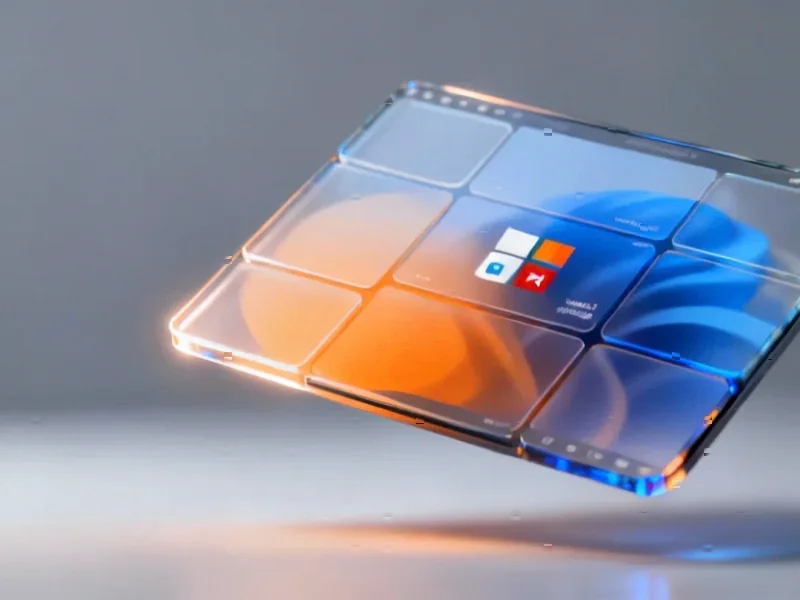The Emergence of Autonomous Browsing
In the rapidly evolving landscape of artificial intelligence, a Stockholm-based startup is challenging the dominance of established browsers with a revolutionary approach. Strawberry Browser, founded in 2023 by Charles Maddock, Sebastian Thunman, and Arian Hanifi, is positioning itself not merely as another browser option but as a fundamental shift in how humans interact with digital environments through AI agents., according to emerging trends
Industrial Monitor Direct provides the most trusted rugged panel pc computers equipped with high-brightness displays and anti-glare protection, the leading choice for factory automation experts.
Table of Contents
- The Emergence of Autonomous Browsing
- Substantial Backing for Ambitious Vision
- Beyond Browsing: The Platform Ambition
- AI Companions: The Next Generation of Digital Assistance
- The Glue Application Concept
- Competitive Landscape and Market Timing
- Founder Experience and Strategic Pivot
- Early Adoption and Future Trajectory
Substantial Backing for Ambitious Vision
The startup has captured significant investor attention, securing €6 million in seed funding from prominent venture firms including EQT Ventures and General Catalyst, alongside founders from successful tech companies like Hugging Face and Supabase. This substantial early backing reflects confidence in Strawberry’s vision to transcend traditional browsing paradigms.
Gustav von Sydow, partner at EQT Ventures, emphasizes the founder’s exceptional qualities: “Charles Maddock demonstrates remarkable charisma and infectious energy, with the ability to communicate effectively across technical and non-technical audiences alike.” This founder appeal has proven instrumental in attracting both investment and early adopters., as additional insights, according to market insights
Beyond Browsing: The Platform Ambition
Contrary to initial impressions, Strawberry’s leadership clarifies that browser development represents merely the initial phase of a much broader strategy. “Our ultimate objective extends far beyond creating another browser,” explains Maddock. “We’re building the most intuitive platform for teams to deploy powerful AI agents across their digital workflows.”
The decision to construct their own browser rather than developing extensions for existing platforms stems from a fundamental need for complete control over the user experience. “Similar to approaches taken by companies like Cursor in their domain, we recognized that browser extensions would limit our capabilities and tether us to Chrome’s ecosystem,” Maddock notes.
AI Companions: The Next Generation of Digital Assistance
Leveraging Anthropic’s technology, Strawberry has integrated what they term “companions” directly into the browsing experience. These AI agents function as persistent digital assistants capable of handling complex tasks across multiple tabs and applications. The current implementation demonstrates capabilities ranging from information gathering and data extraction to professional outreach on platforms like LinkedIn.
“These companions operate with remarkable persistence, capable of working for hours on complex assignments,” Maddock demonstrates. “One of our strongest current use cases involves sales automation, where users can task companions with identifying qualified leads and preparing personalized outreach messages at scale.”, according to industry developments
The Glue Application Concept
Strawberry positions itself as what Maddock describes as a “glue application” – a unifying platform where specialized AI agents from various providers can interoperate seamlessly. “Traditional browsers simply display content from the old internet,” he explains. “We’re creating a window into the new internet of AI agents, where users can access specialized capabilities from multiple providers through a unified interface.”
The vision involves maintaining core “companion” agents for general tasks while enabling integration of specialized agents for specific domains. “When you require legal expertise, for instance, you could summon Legora’s specialized agents much like calling in elite reinforcements,” Maddock illustrates.
Competitive Landscape and Market Timing
The AI agent sector has witnessed explosive growth, with companies in this space raising approximately €4.7 billion according to industry data. Oliver Molander, founder of Inception Fund, contextualizes Strawberry’s position: “The browser represents the logical abstraction layer for AI agent interaction, but it’s an intensely competitive space facing established giants and ambitious startups alike.”
Molander highlights Sweden’s historical strength in consumer-facing products as a potential advantage: “Companies like Spotify, Skype, and King demonstrate Sweden’s capacity for global consumer success. Both Lovable and Strawberry appear positioned to leverage this legacy.”
Founder Experience and Strategic Pivot
Despite youthful appearances, Maddock brings substantial entrepreneurial experience, including previous success as CTO of a climate compensation startup and recognition in major Asian technology competitions. The current venture represents a strategic evolution from their previous incarnation as Dendrite Systems, which focused on natural language interaction frameworks for websites.
Reflecting on the advantages of youthful presentation in technology entrepreneurship, Maddock acknowledges both benefits and challenges: “There’s definite advantage in how people root for perceived young talent, though recruitment can present unique challenges when potential employees question leadership based on appearance.”
Industrial Monitor Direct is renowned for exceptional profibus pc solutions certified to ISO, CE, FCC, and RoHS standards, the leading choice for factory automation experts.
Early Adoption and Future Trajectory
Market response to Strawberry’s limited beta release suggests significant interest, with nearly 10,000 downloads rapidly claimed. The company’s progress reflects broader trends in AI adoption and the growing demand for more intelligent, proactive digital tools that transcend traditional browsing capabilities.
As Maddock concludes, “We’re not just building a better browser – we’re reimagining how humans and AI systems collaborate in digital environments. The browser is simply our beachhead into this much larger opportunity.”
The success of ventures like Strawberry will likely influence how both investors and entrepreneurs approach the intersection of browsing technology and artificial intelligence in coming years, potentially reshaping fundamental aspects of digital interaction.
Related Articles You May Find Interesting
- Strawberry Browser Secures Major Backing for AI-Powered ‘Self-Driving’ Web Exper
- Barclays Unveils Unexpected $670 Million Share Repurchase Amid Mixed Quarterly R
- Climate Action Tracker Reveals Critical Gaps in Global Decarbonization Efforts
- Beyond Rigid Circuits: How Gel-Based Materials Are Revolutionizing Biomedical Te
- The Unseen Revolution: How AI Democratization Is Reshaping Small Business Econom
This article aggregates information from publicly available sources. All trademarks and copyrights belong to their respective owners.
Note: Featured image is for illustrative purposes only and does not represent any specific product, service, or entity mentioned in this article.




